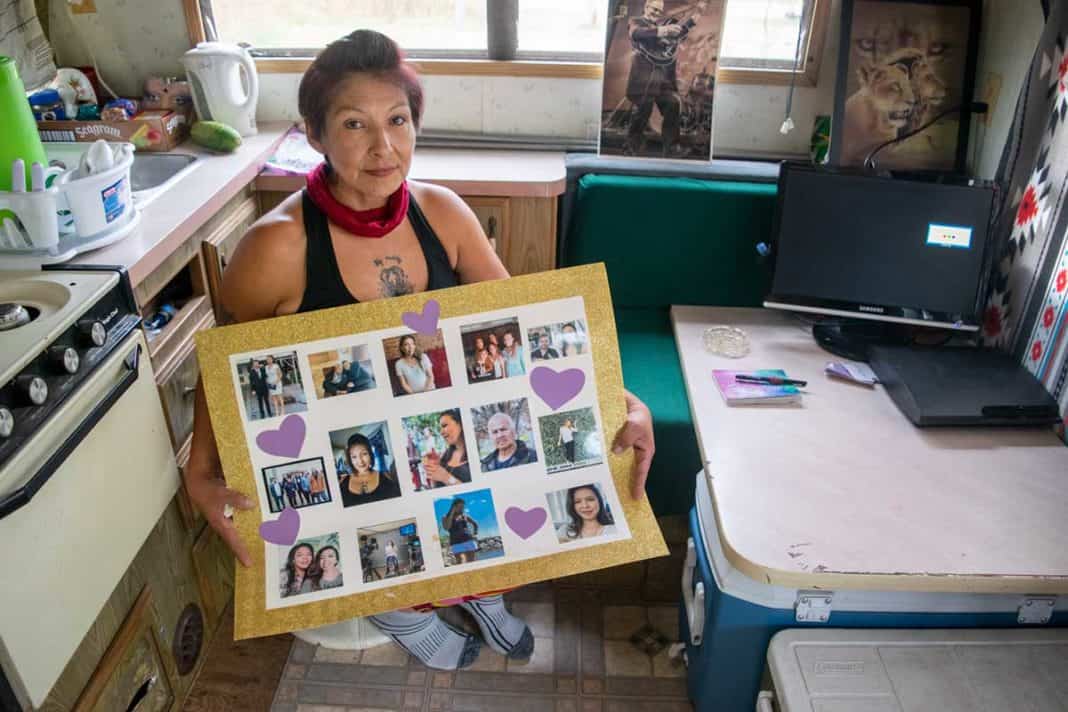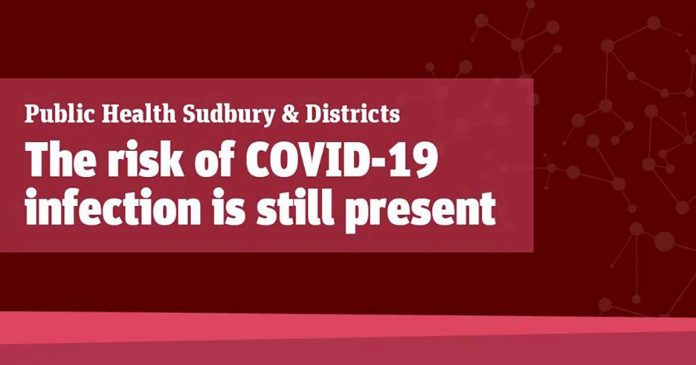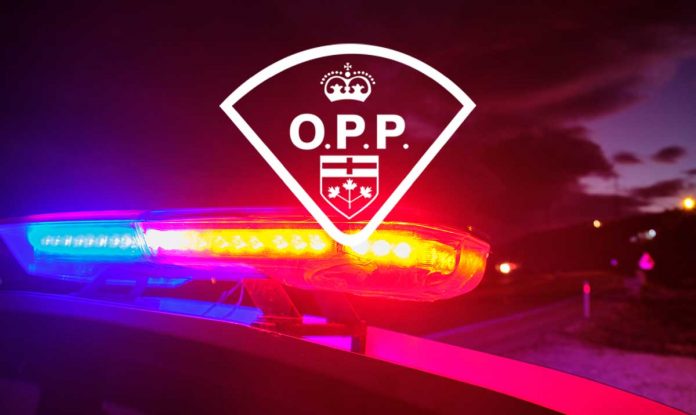EDITOR’S NOTE: This story is about a transgender two-spirit Indigenous woman who died in a homicide this past summer. The story may be disturbing to some readers. Please see the footnote for available support resources.
HAMILTON – On August 23, someone killed Kristen Shawanda.
That day, Manitoulin Island and Hamilton lost a vibrant community member, a young two-spirit transgender woman who had a love for life, was a strong advocate for her friends and the causes she supported. This incident is part of a disturbing pattern of higher rates of violence against Indigenous women and girls that has been centuries in the making.
The loss is still painful two months later for the people she loved and the Island community that helped to raise her—and in some ways, whom she helped to raise.
In a small, smoky trailer home in Sheguiandah First Nation, Cheryl Sovie sits in a corner of her kitchen, holding up a posterboard of photos from her daughter’s life. Her husband stokes the woodstove as they share memories of Ms. Sovie’s daughter Kristen, naming the people in the photographs that shaped her daughter’s 27-year life.
“She was very outgoing, very vocal,” says Ms. Sovie. “She had a good sense of humour and she liked other people.”
Ms. Shawanda had been living in southern Ontario for the past seven years. She studied nursing and worked in the health care field, completed academic upgrading and went back to school for business.
“Whatever she could grasp at, she did, she went for. She knew she could do whatever she wanted to set her mind at. That was awesome about her,” says Ms. Sovie.
But her daughter’s existence as an Indigenous woman in Canada, especially a trans Indigenous woman, made her vulnerable to experiencing violence.

Indigenous women, girls at higher risk
Between 1980 and 2012, there were 1,017 female Indigenous homicide victims, roughly 16 percent of all 6,551 female homicide victims in Canada, according to the National Inquiry into Missing and Murdered Indigenous Women and Girls (MMIWG). Indigenous women comprise just 4.3 percent of all women in Canada, putting the rate nearly four times higher than the population.
Several studies have shown that transgender people face poorer health outcomes, higher rates of violence and economic disadvantages when compared to their peers.
An Ontario study involving gender-diverse and two-spirit Indigenous people found 73 percent of respondents faced some form of transphobic violence and 43 percent had experienced physical or sexual violence, or both.
Ms. Sovie says she thinks her daughter’s trans identity, more than her Indigenous heritage, is what contributed to her death.
“It’s the transgender part of it that I think about the most. Not the fact that she was Native. I find that her lifestyle had a huge impact as to why this occurred, but that’s my own thinking,” she says. “Whether it was, I don’t know. And I won’t know, I guess.”
The police investigation
Finding information on Ms. Shawanda’s case proved challenging, as Hamilton Police did not have a file for ‘Kristen Shawanda.’ She was born Kristian Shawanda on April 14, 1993 and, after moving south, got married and took on the last name Ibrahim. Her marriage later ended and she went back to using her Shawanda surname, but her legal documents still carried the name Kristian Ibrahim.
A Hamilton Police spokesperson referred The Expositor’s inquiry to the Office of the Chief Coroner and Forensic Pathology Service, as the coroner had taken over the investigation.
Neither agency would comment on the case or the nature of the investigation but Ms. Sovie says her daughter’s death is considered a homicide at this time. There were reportedly drugs involved but the toxicology report will not be ready for three months. She had more than one sexual partner in her life and investigators believe she knew the person she was with at the time of her death, says her mother.
Indigenous peoples’ experiences with the justice system are often challenging, owing to the acknowledged systemic racism within Canadian institutions.
However, the family members say they are confident that police are doing as much as they can. Kathleen Carson-Shawanda, the wife of Ms. Sovie’s son, has been a major part of the investigative process. She has a police foundations education and has helped the family ask the right questions and keep pressure on investigators.
Ms. Sovie says her daughter-in-law, who is White, may have a different experience navigating the policing system than an Indigenous person. Ms. Carson-Shawanda has also worked in partnership with nearby Native friendship centres to write letters in support of a full, thorough investigation.
Ms. Sovie has not travelled to Hamilton because of the difficult circumstances but family members and friends have made trips on her behalf.
Kristen Shawanda changed her community
One of Ms. Shawanda’s family members from Sheguiandah, who has requested anonymity to ensure the conversation stays about her, says he will always remember the transformative effects Ms. Shawanda had on Sheguiandah First Nation.
“She set the stage for a lot of people in my community. She was the first person who was really open about her sexuality; she never really said it, it was just kind of known. It gave other people the opportunity to take her lead and not be scared to be open about themselves,” he says.
He holds some fear that the back-and-forth process between police and the coroner may result in a lengthy investigation with no concrete conclusions, and says he hopes they don’t write off the case without arriving at a meaningful answer.
The day after her death, he and another of Ms. Shawanda’s cousins went to the house in Hamilton where she died to perform a ceremony. They sought to send her spirit back to Manitoulin so her family could also conduct their own ceremonies at a sacred fire as she began her journey to the spirit world.
Family connections
Ms. Sovie says she knows Ms. Shawanda went through tough times in her youth but there are gaps in her knowledge.
Ms. Shawanda grew up with her father Richard Shawanda, the late former chief of Sheguiandah, after he and Ms. Sovie separated around 1996. She was close to her father and there was a trans person in the family already.
“We could see it from the time she started learning how to talk. She was very feminine and we could see that side of her, but she didn’t actually discover herself until she was probably about 12 or 13, when she came out to us. I had always known; I was just waiting for her time to tell me,” says Ms. Sovie.
Her and her daughter were working on reconnecting and returning to each other’s lives in recent years. Ms. Shawanda’s experiences working in health care showed her how people who are HIV-positive, such as her mother, often face gaps in care compared to their peers.
Ms. Sovie is still working to process what has happened to her daughter and says the family maintains hope that they will find answers soon.
“Right now it’s just taking it day by day. My biggest thing is I hope she didn’t suffer,” she says. “It’s definitely been one of the hardest things I’ve had to face in my life.”
The family member who helped with the ceremony at Ms. Shawanda’s home adds that anyone wishing to support the process could write letters of support to Hamilton Police, the Hamilton coroner’s office or to that community’s legal clinic.
“Hopefully they see how many people are waiting and supporting this case, and hopefully that will push them to really dig for more answers and close this case as soon as possible with the best possible outcome,” he says.
• • •
LGBTQ2+ youth who need support should visit YouthLine.ca for anonymous help; Canada operates the Hope for Wellness help line for Indigenous persons at 1-855-242-3310 or HopeForWellness.ca.





